Hybridization of the Stockwell Transform and Wigner Distribution Function to Design a Transmission Line Protection Scheme
Abstract
1. Introduction
- An algorithm, which is supported by the S-transform and Wigner distribution function to provide protection to the transmission line and which is effective at eliminating the requirement of GPS and the communication system, is introduced in this paper.
- The developed algorithm is less complex and effective at identifying and classifying faults on the transmission line within the duration of a quarter cycle.
- This algorithm accurately recognizes the faults using the measurement of the current signal at a single end of the transmission line.
2. Modified Case Study System
3. Proposed Fault Detection and Classification Algorithm
3.1. S-Index
3.2. W-Index
3.3. Fault Index
3.4. Ground Fault Index
3.5. Flowchart of the Proposed Technique
4. Transmission Line Fault Detection
5. Transmission Line Fault Classification
6. Fault Detection and Classification Case Studies
6.1. Variation of the Fault Location
6.2. Variable Fault Impedance
6.3. Fault Incidence Angle Variation
6.4. Additional Case Studies
7. Testing of the Algorithm to Discriminate Switching Events from Faults
7.1. Capacitive Switching
7.2. Inductive Switching
8. Performance Comparison
9. Conclusions
Author Contributions
Funding
Conflicts of Interest
Abbreviations
| CSAE | Convolutional sparse auto-encoder |
| FDOST | Fast discrete orthogonal Stockwell transform |
| FI | Fault index |
| GFI | Ground fault index |
| GFTH | Ground fault index threshold value |
| GPS | Global Positioning System |
| GSS | Grid substations |
| HT | Hilbert transform |
| L-G | Phase-to-ground fault |
| LL | Two phase fault |
| LL-G | Two phases-to-ground fault |
| LLL-G | Three phases-to-ground fault |
| MATLAB | Matrix Laboratory |
| PTL | Power transmission line |
| SAV | Sum absolute values |
| SNR | Signal-to-noise ratio |
| S-transform | Stockwell transform |
| ST | Stockwell transform |
| TH | Fault threshold |
| UG | Underground |
| WD | Wigner distribution |
| WDF | Wigner distribution function |
| WPT | Wavelet packet transform |
| WT | Wavelet transform |
References
- Prasad, C.; Nayak, P.K. A DFT-ED based approach for detection and classification of faults in electric power transmission networks. Ain Shams Eng. J. 2019, 10, 171–178. [Google Scholar] [CrossRef]
- Musa, M.H.; He, Z.; Fu, L.; Deng, Y. A covariance indices based method for fault detection and classification in a power transmission system during power swing. Int. J. Electr. Power Energy Syst. 2019, 105, 581–591. [Google Scholar] [CrossRef]
- Rathore, B.; Shaik, A.G. Wavelet-alienation based transmission line protection scheme. IET Gener. Transm. Distrib. 2017, 11, 995–1003. [Google Scholar] [CrossRef]
- Peng, N.; Zhou, L.; Liang, R.; Xu, H. Fault location of transmission lines connecting with short branches based on polarity and arrival time of asynchronously recorded traveling waves. Electr. Power Syst. Res. 2019, 169, 184–194. [Google Scholar] [CrossRef]
- Lee, C.J.; Park, J.B.; Shin, J.R.; Radojevie, Z.M. A new two-terminal numerical algorithm for fault location, distance protection, and arcing fault recognition. IEEE Trans. Power Syst. 2006, 21, 1460–1462. [Google Scholar] [CrossRef]
- Rathore, B.; Mahela, O.P.; Khan, B.; Haes Alhelou, H.; Siano, P. Wavelet-Alienation-Neural Based Protection Scheme for STATCOM Compensated Transmission Line. IEEE Trans. Ind. Inf. 2020. [Google Scholar] [CrossRef]
- Chen, K.; Hu, J.; He, J. Detection and Classification of Transmission Line Faults Based on Unsupervised Feature Learning and Convolutional Sparse Autoencoder. IEEE Trans. Smart Grid 2018, 9, 1748–1758. [Google Scholar] [CrossRef]
- Sharma, R.; Mahela, O.P.; Agarwal, S. Detection of Power System Faults in Distribution System Using Stockwell Transform. In Proceedings of the 2018 IEEE International Students’ Conference on Electrical, Electronics and Computer Science (SCEECS), Bhopal, India, 24–25 February 2018; pp. 1–5. [Google Scholar] [CrossRef]
- Adly, A.R.; Aleem, S.H.E.A.; Algabalawy, M.A.; Jurado, F.; Ali, Z.M. A novel protection scheme for multi-terminal transmission lines based on wavelet transform. Electr. Power Syst. Res. 2020, 183, 106286. [Google Scholar] [CrossRef]
- Ola, S.R.; Saraswat, A.; Goyal, S.K.; Jhajharia, S.K.; Rathore, B.; Mahela, O.P. Wigner distribution function and alienation coefficient-based transmission line protection scheme. IET Gener. Transm. Distrib. 2020, 14, 1842–1853. [Google Scholar] [CrossRef]
- Ram Ola, S.; Saraswat, A.; Goyal, S.K.; Jhajharia, S.K.; Khan, B.; Mahela, O.P.; Haes Alhelou, H.; Siano, P. A Protection Scheme for a Power System with Solar Energy Penetration. Appl. Sci. 2020, 10, 1516. [Google Scholar] [CrossRef]
- Ola, S.R.; Saraswat, A.; Goyal, S.K.; Sharma, V.; Khan, B.; Mahela, O.P.; Alhelou, H.H.; Siano, P. Alienation Coefficient and Wigner Distribution Function Based Protection Scheme for Hybrid Power System Network with Renewable Energy Penetration. Energies 2020, 13, 1120. [Google Scholar]
- Adly, A.R.; Ali, Z.M.; Elsadd, M.A.; Abdel Mageed, H.M.; Abdel Aleem, S.H. An integrated scheme for a directional relay in the presence of a series-compensated line. Int. J. Electr. Power Energy Syst. 2020, 120, 106024. [Google Scholar] [CrossRef]
- Patel, B. A new FDOST entropy based intelligent digital relaying for detection, classification and localization of faults on the hybrid transmission line. Electr. Power Syst. Res. 2018, 157, 39–47. [Google Scholar] [CrossRef]
- Malhotra, A.; Mahela, O.P.; Doraya, H. Detection and Classification of Power System Faults using Discrete Wavelet Transform and Rule Based Decision Tree. In Proceedings of the 2018 International Conference on Computing, Power and Communication Technologies (GUCON), Greater Noida, Uttar, 28–29 September 2018; pp. 142–147. [Google Scholar] [CrossRef]
- Kulshrestha, A.; Mahela, O.P.; Gupta, M.K. Identification and Classification of Faults in Utility Grid with Solar Energy Using Discrete Wavelet Transform and Decision Rules. In Proceedings of the 2020 12th International Conference on Computational Intelligence and Communication Networks (CICN), Bhimtal, India, 25–26 September 2020; pp. 251–257. [Google Scholar] [CrossRef]
- Mahela, O.P.; Sharma, J.; Kumar, B.; Khan, B.; Alhelou, H.H. An algorithm for the protection of distribution feeder using Stockwell and Hilbert transforms supported features. CSEE J. Power Energy Syst. 2020, 1–9. [Google Scholar] [CrossRef]
- Karmakar, S.; Ahmad, G.; Mahela, O.P.; Choudhary, R.R. Algorithm Based on Combined Features of Stockwell Transform and Hilbert Transform for Detection of Transmission Line Faults with Dynamic Load. In Proceedings of the 2020 First International Conference on Power, Control and Computing Technologies (ICPC2T), Raipur, India, 3–5 January 2020; pp. 354–358. [Google Scholar] [CrossRef]
- Karmakar, S.; Mahela, O.P.; Ahmad, G.; Choudhary, R.R. Transmission Line Protection Scheme Based on Combined Features of Stockwell Transform and Hilbert Transform. In Proceedings of the 2020 First International Conference on Power, Control and Computing Technologies (ICPC2T), Raipur, India, 3–5 January 2020; pp. 348–353. [Google Scholar] [CrossRef]
- Stockwell, R.G.; Mansinha, L.; Lowe, R.P. Localization of the complex spectrum: The S transform. Signal Process. IEEE Trans. 1996, 44, 998–1001. [Google Scholar] [CrossRef]
- Behera, H.S.; Dash, P.K.; Biswal, B. Power quality time series data mining using S-transform and fuzzy expert system. Appl. Soft Comput. 2010, 10, 945–955. [Google Scholar] [CrossRef]
- Khan, N.A.; Taj, I.A.; Jaffri, M.N.; Ijaz, S. Cross-term elimination in Wigner distribution based on 2D signal processing techniques. Signal Process. 2011, 91, 590–599, Advances in Fractional Signals and Systems. [Google Scholar] [CrossRef]
- Cheng, J.Y.; Huang, S.J.; Hsieh, C.T. Application of Gabor–Wigner transform to inspect high-impedance fault-generated signals. Int. J. Electr. Power Energy Syst. 2015, 73, 192–199. [Google Scholar] [CrossRef]
- Shaik, A.G.; Pulipaka, R.R.V. A new wavelet based fault detection, classification and location in transmission lines. Int. J. Electr. Power Energy Syst. 2015, 64, 35–40. [Google Scholar] [CrossRef]
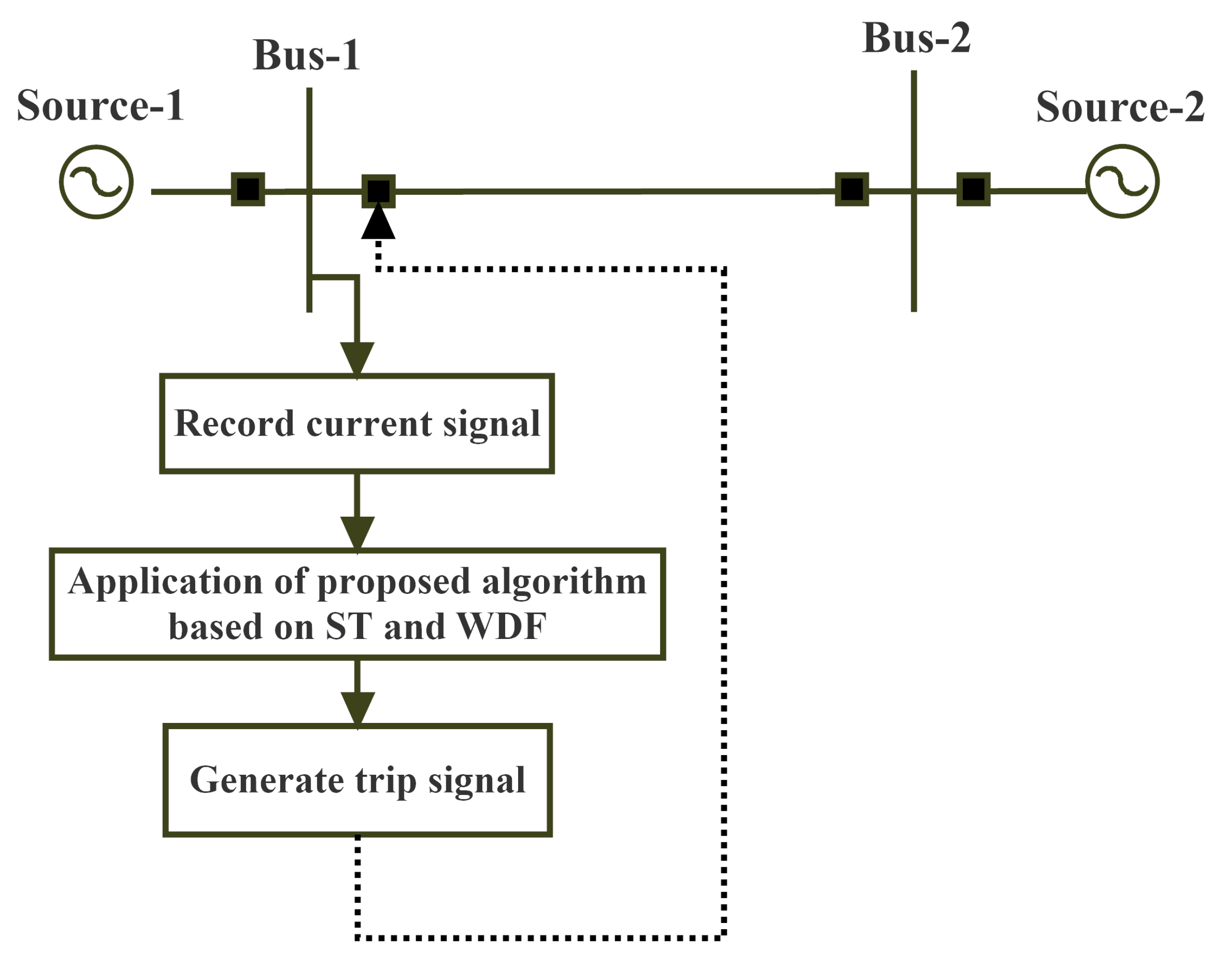
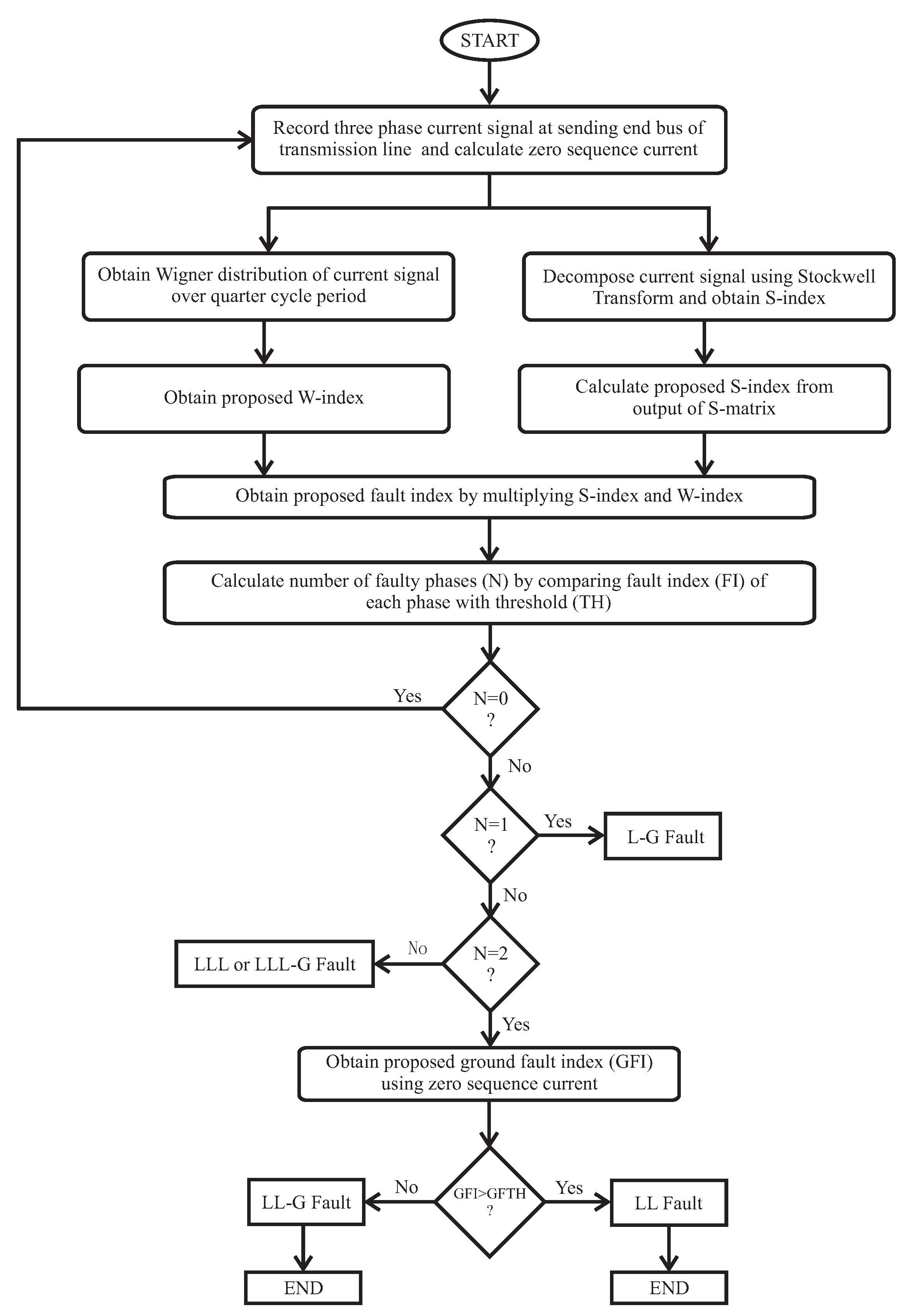

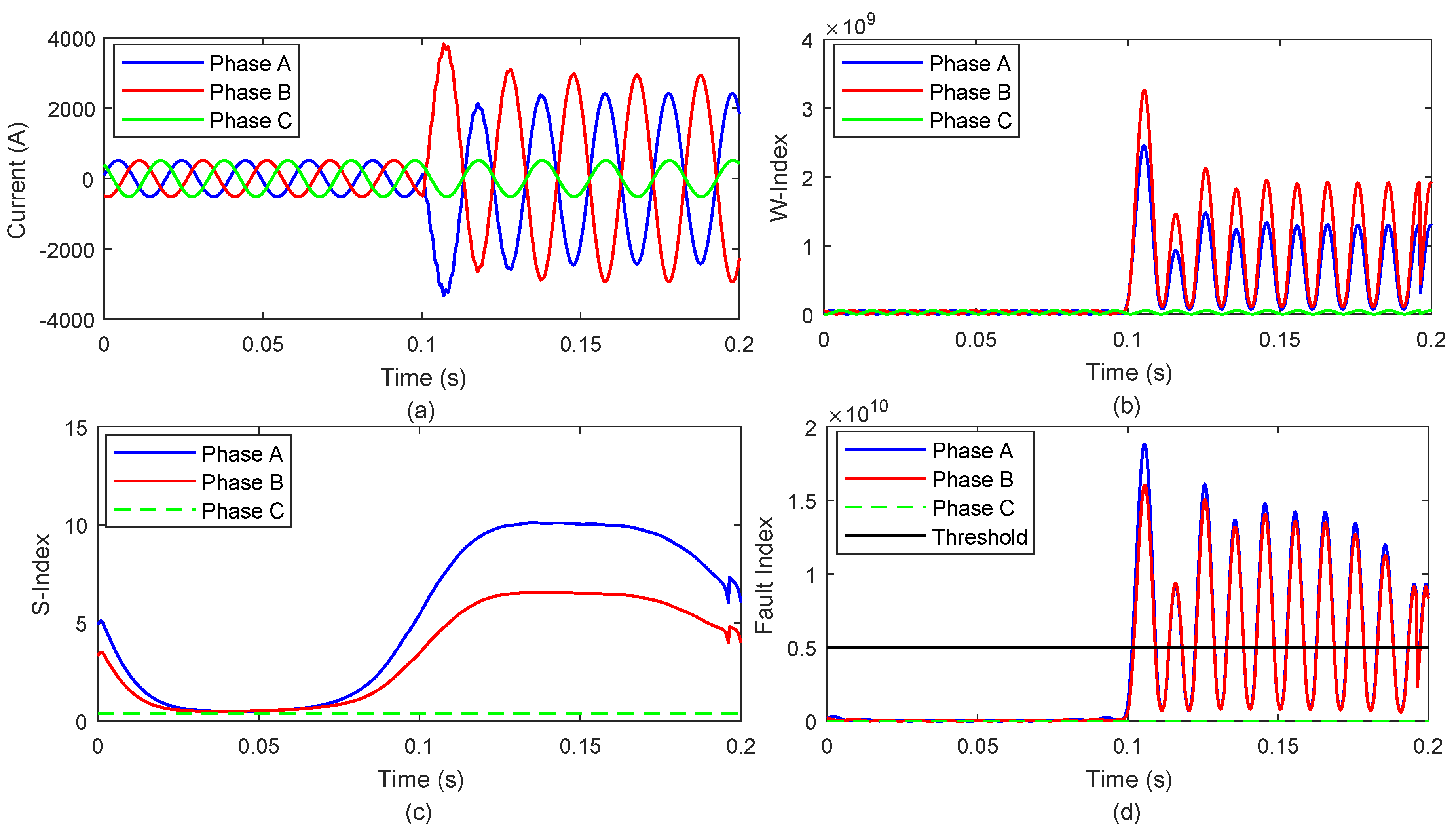
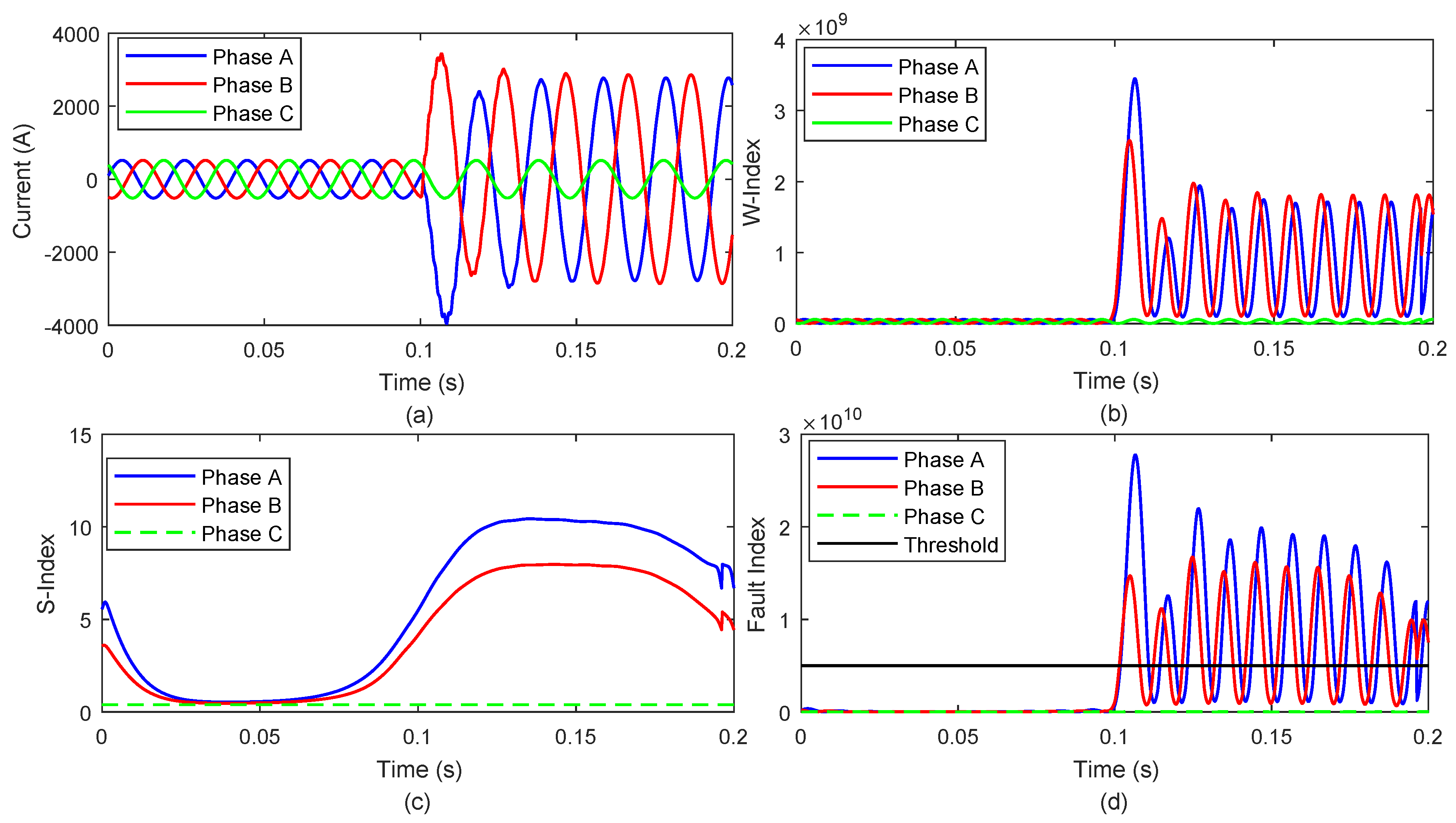
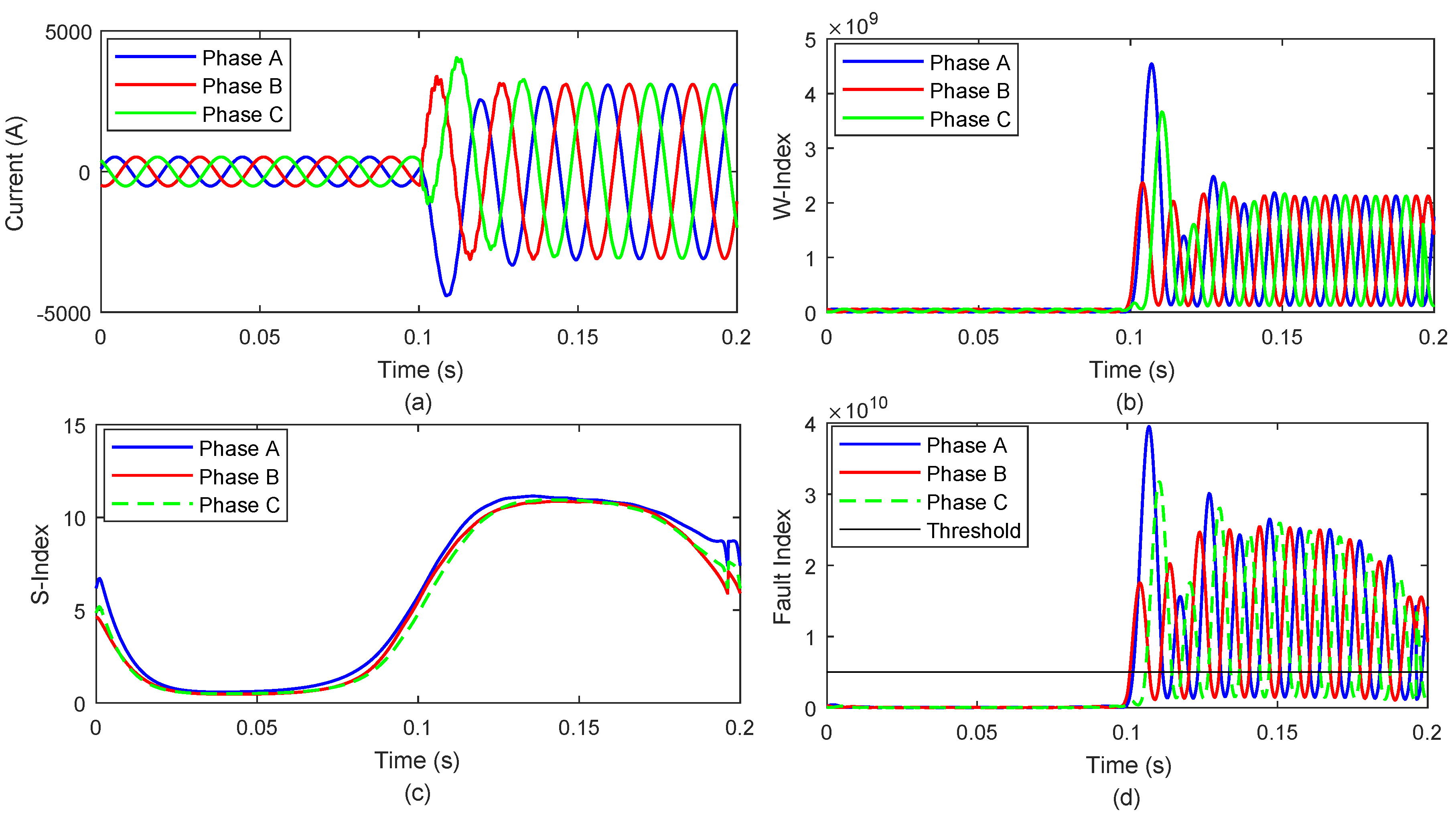
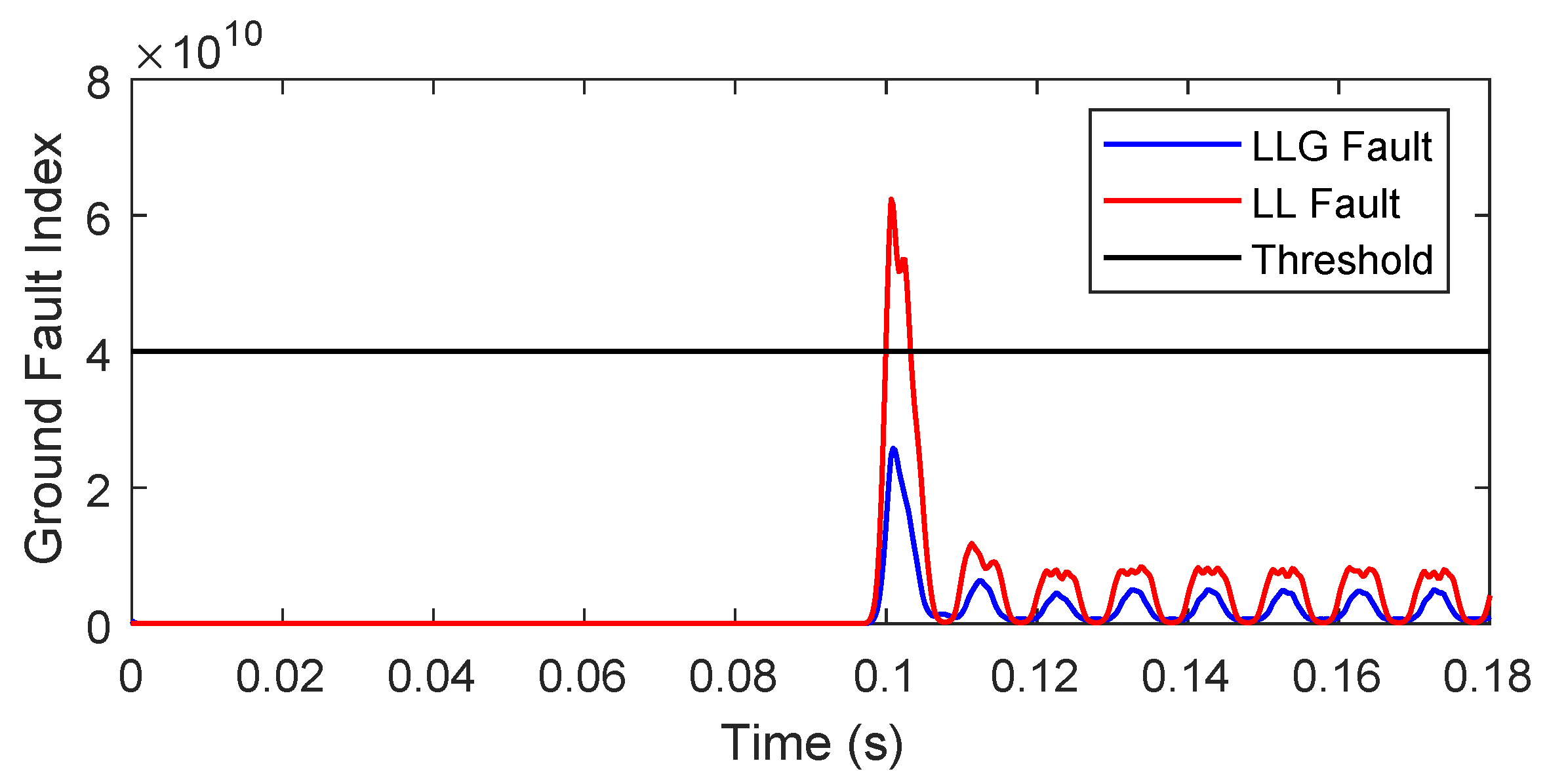
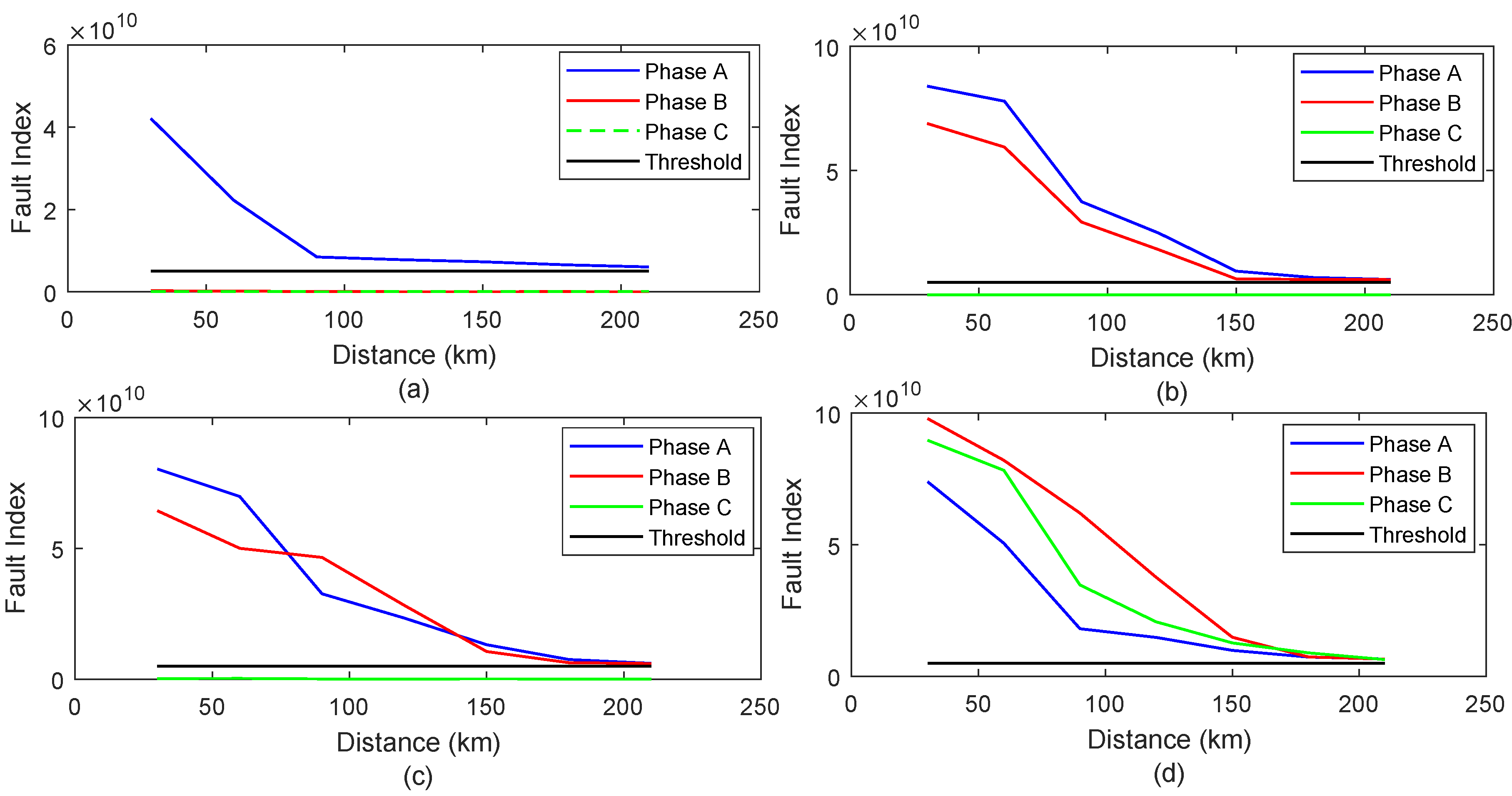
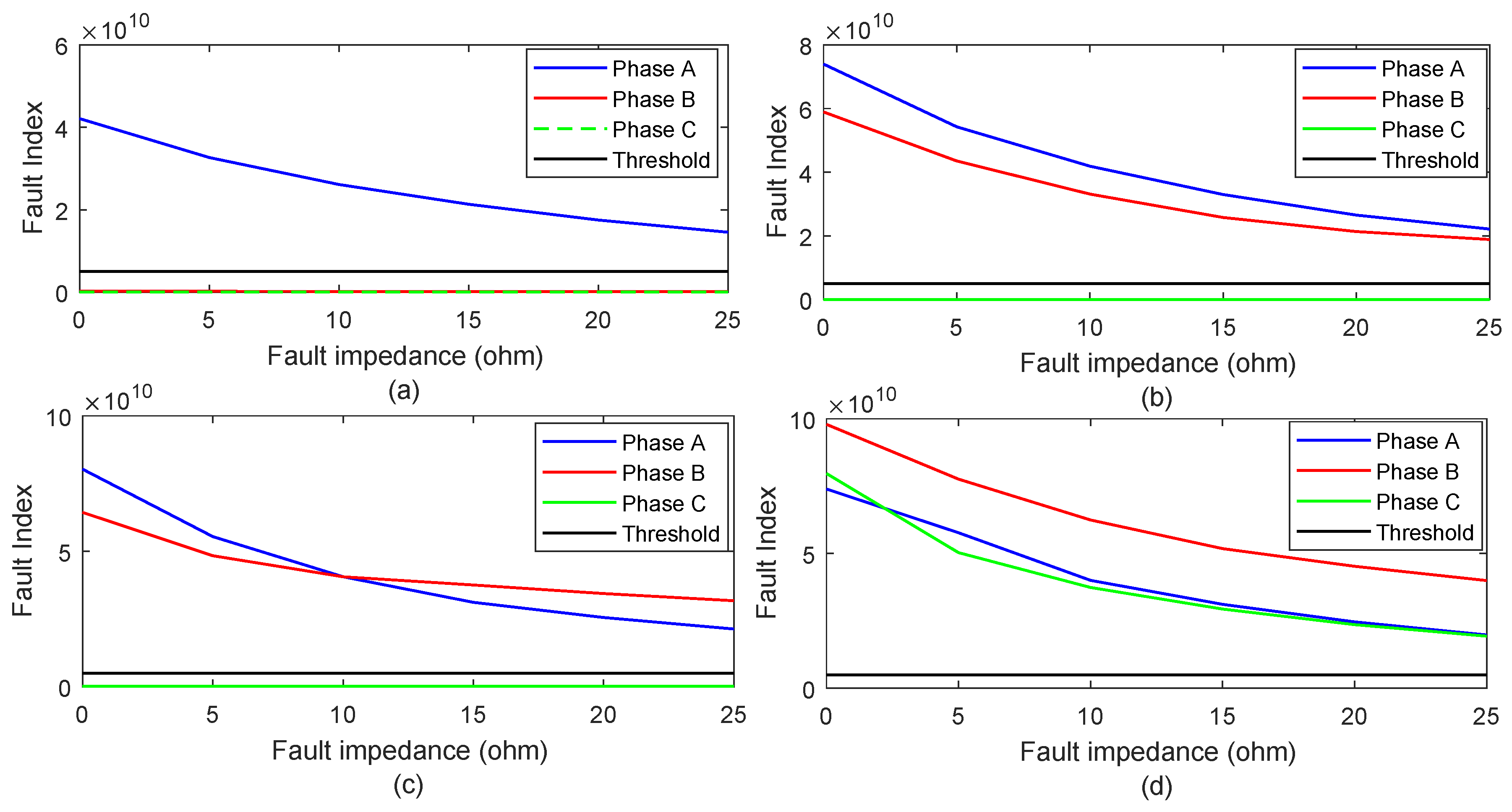
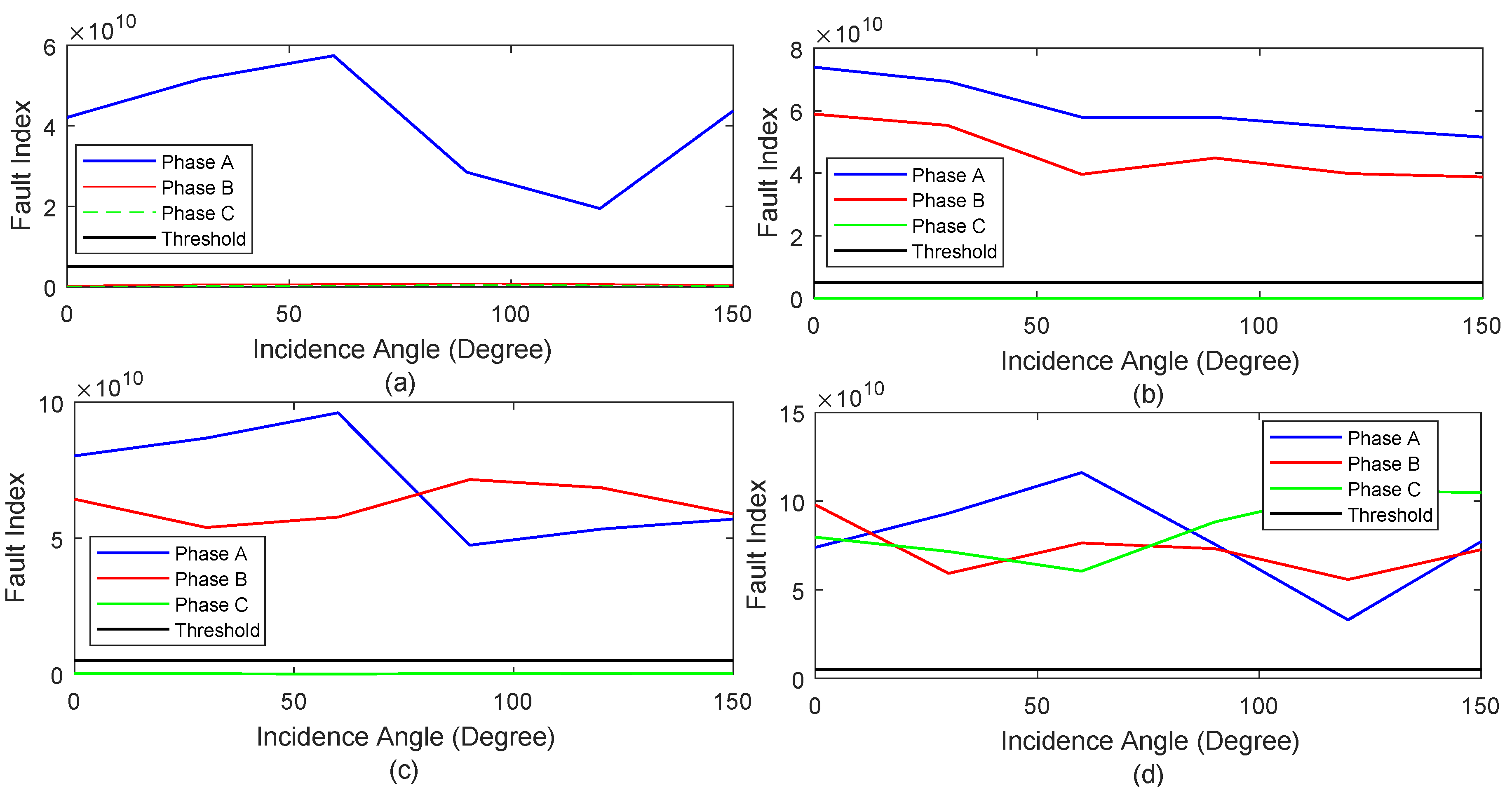
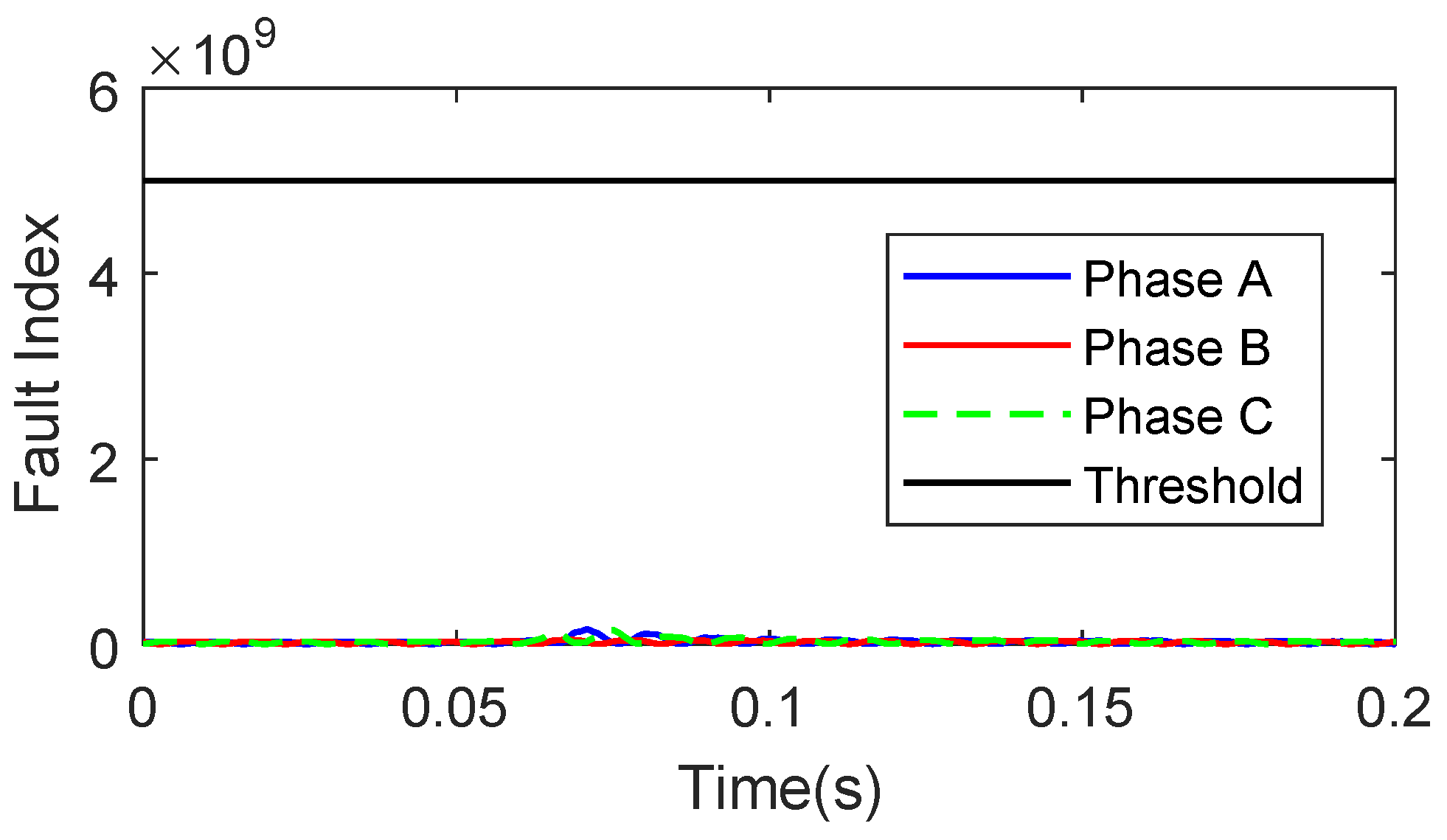
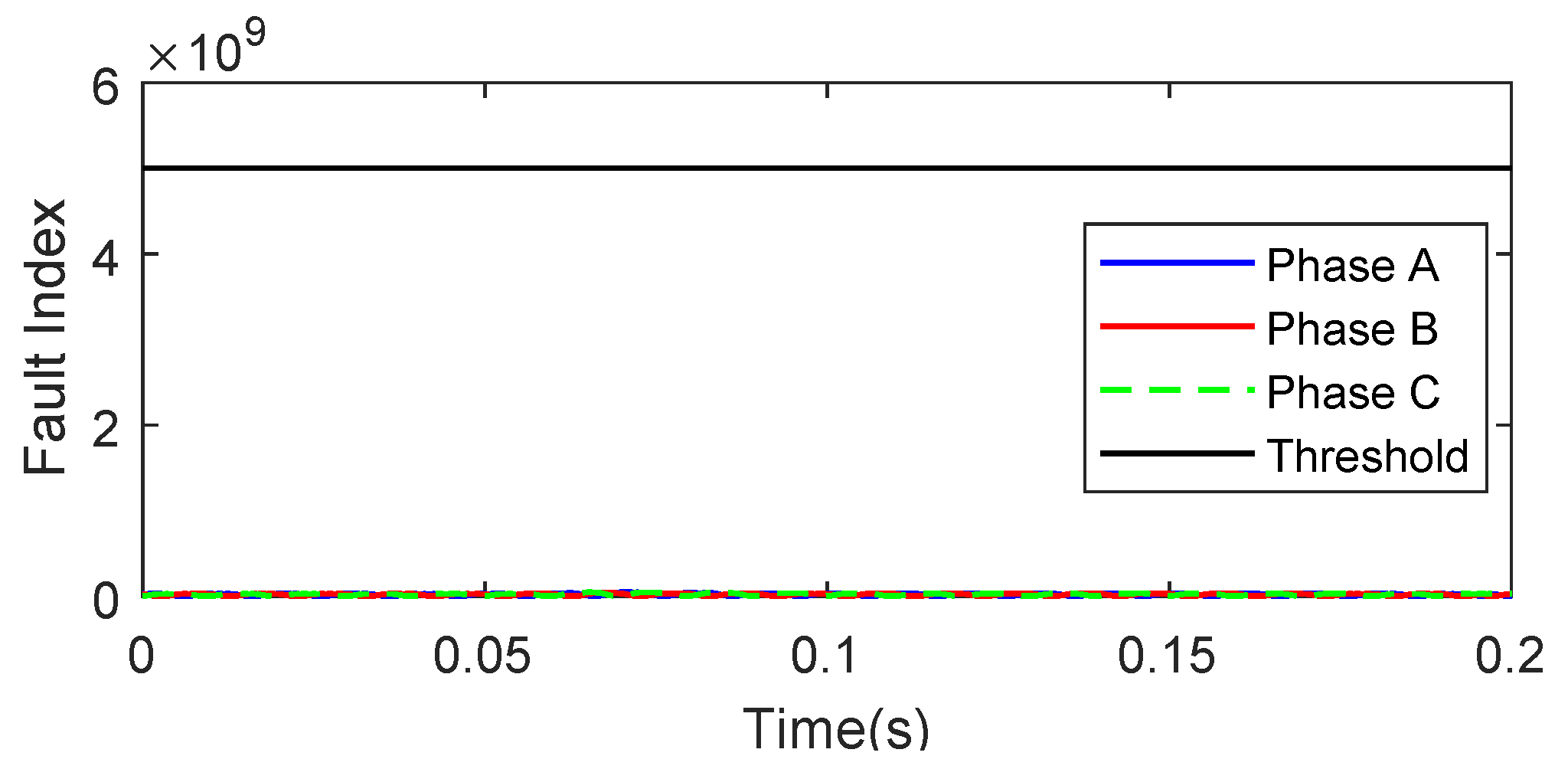
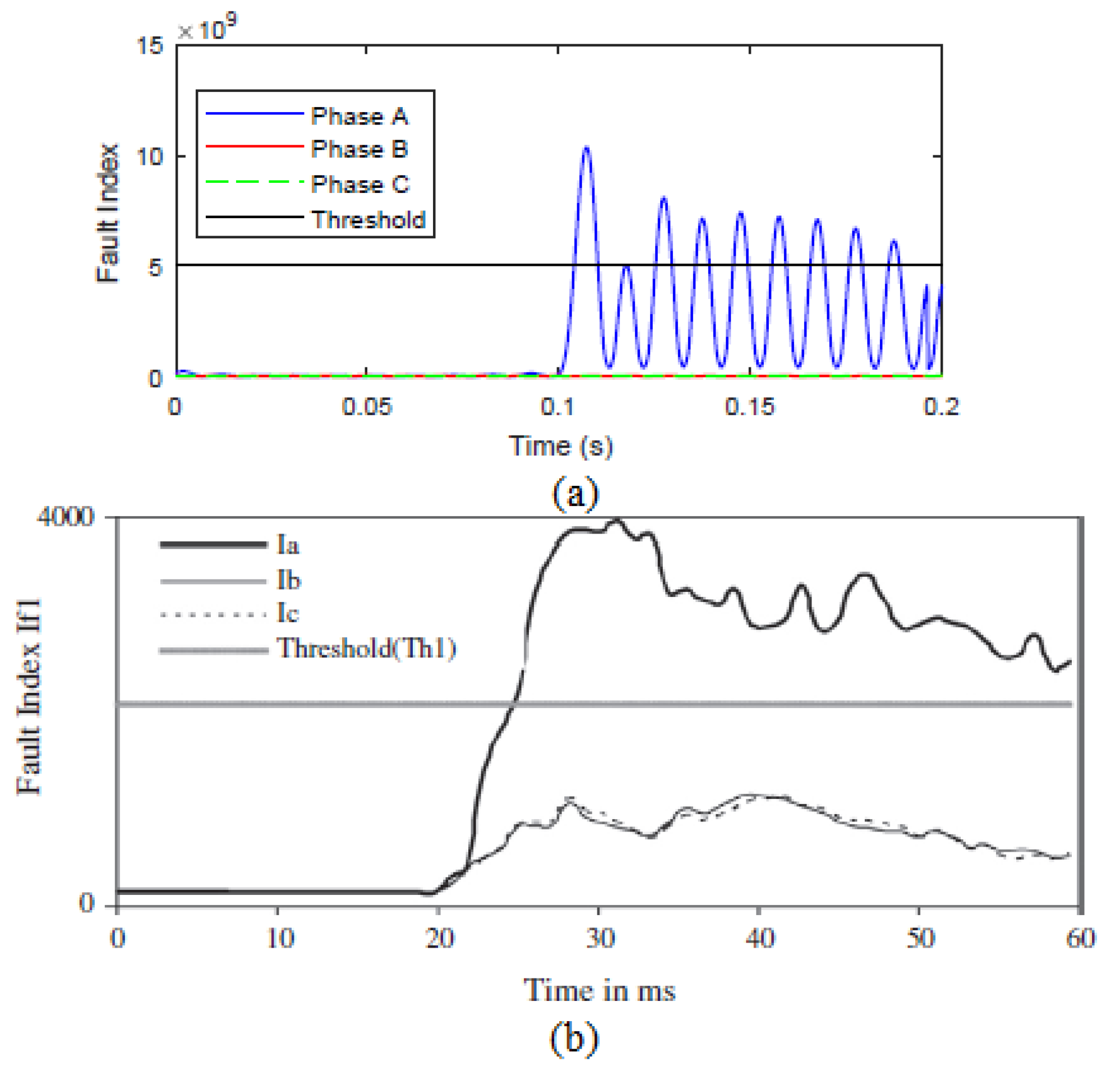
| System Parameter | Simulated Parameter |
|---|---|
| Line length | 230 km |
| Generator 1 voltage | 500 ∠ 20° kV |
| Generator 2 voltage | 500 ∠ 0° kV |
| Generator 1 impedance (equivalent) | 17.177 + j45.529 |
| Generator 2 impedance (equivalent) | 15.31 + j45.925 |
| Transmission link positive sequence impedance | 4.983 + j117.83 |
| Transmission link zero sequence impedance | 12.682 + j364.196 |
| Transmission link admittance (positive sequence) | j1.468 m℧ |
| Transmission link zero sequence admittance | j1.099 m℧ |
| Transmission link rated power (apparent) | 433.63 + j294.52 MVA |
| Case Study | Peak Magnitude of the Fault Index | ||
|---|---|---|---|
| Phase A | Phase B | Phase C | |
| Reverse Power Flow | 96 | 95 | |
| Presence of Noise | 207 | 204 | |
| Hybrid Line | 71 | 70 | |
Publisher’s Note: MDPI stays neutral with regard to jurisdictional claims in published maps and institutional affiliations. |
© 2020 by the authors. Licensee MDPI, Basel, Switzerland. This article is an open access article distributed under the terms and conditions of the Creative Commons Attribution (CC BY) license (http://creativecommons.org/licenses/by/4.0/).
Share and Cite
Kulshrestha, A.; Prakash Mahela, O.; Gupta, M.K.; Khan, B.; Haes Alhelou, H.; Siano, P. Hybridization of the Stockwell Transform and Wigner Distribution Function to Design a Transmission Line Protection Scheme. Appl. Sci. 2020, 10, 7985. https://doi.org/10.3390/app10227985
Kulshrestha A, Prakash Mahela O, Gupta MK, Khan B, Haes Alhelou H, Siano P. Hybridization of the Stockwell Transform and Wigner Distribution Function to Design a Transmission Line Protection Scheme. Applied Sciences. 2020; 10(22):7985. https://doi.org/10.3390/app10227985
Chicago/Turabian StyleKulshrestha, Atul, Om Prakash Mahela, Mukesh Kumar Gupta, Baseem Khan, Hassan Haes Alhelou, and Pierluigi Siano. 2020. "Hybridization of the Stockwell Transform and Wigner Distribution Function to Design a Transmission Line Protection Scheme" Applied Sciences 10, no. 22: 7985. https://doi.org/10.3390/app10227985
APA StyleKulshrestha, A., Prakash Mahela, O., Gupta, M. K., Khan, B., Haes Alhelou, H., & Siano, P. (2020). Hybridization of the Stockwell Transform and Wigner Distribution Function to Design a Transmission Line Protection Scheme. Applied Sciences, 10(22), 7985. https://doi.org/10.3390/app10227985







